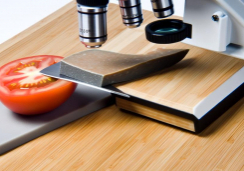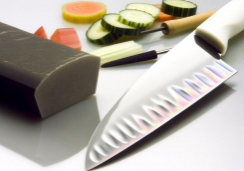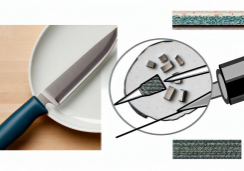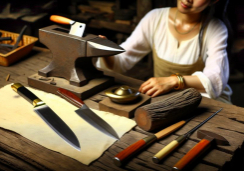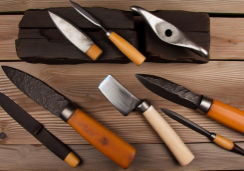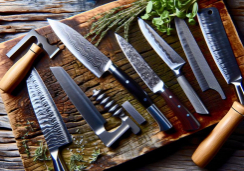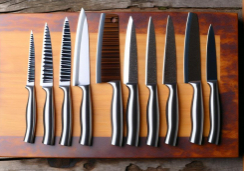Top Steel Choices for Superior Kitchen Knives
You might not be aware that the famed Damascus steel, renowned for its distinctive wavy pattern, isn't just about aesthetics—it's also a symbol of exceptional strength and sharpness in kitchen knives.
As you consider the array of cutlery for your culinary endeavors, you'll find that each type of steel offers its unique blend of properties, from the edge retention and easy sharpening of high-carbon steel to the rust resistance and durability of stainless steel.
High-carbon stainless steel might seem like the best of both worlds, but the true question lies in its performance in your hands and your kitchen's environment.
Meanwhile, ceramic blades are entering the fray, boasting an impressive hardness that challenges traditional steel.
It's essential to weigh these options carefully, because the right choice will elevate your cooking precision and enjoyment to new heights.
Let's explore the subtleties that distinguish these materials and guide you to the knife that feels like an extension of your own culinary prowess.
Carbon Steel Advantages
Carbon steel, revered for its exceptional sharpness retention, offers significant advantages to culinary enthusiasts seeking durable and efficient kitchen knives. You'll find that this metal alloy, typically composed of iron with a carbon content ranging from 0.6% to 1.2%, outperforms many of its counterparts in maintaining a razor-sharp edge. The higher carbon content in these blades not only contributes to edge retention but also allows for a more acute sharpening angle, resulting in unparalleled precision during your food preparation tasks.
Moreover, you can easily hone a carbon steel knife to restore its sharpness, unlike some stainless steel knives that require professional re-sharpening. This ease of maintenance ensures that your knife remains at peak performance with minimal downtime. Additionally, carbon steel's toughness reduces the likelihood of chipping and cracking under strenuous kitchen activities, providing a robust tool that withstands the rigors of daily use.
However, it's crucial to note that carbon steel knives demand more attentive care to prevent corrosion and rust. Regular cleaning, drying, and application of a light coat of oil will preserve the integrity of the blade. Embracing these maintenance practices, you'll leverage carbon steel's superior qualities for a consistently high-performing kitchen knife.
Stainless Steel Versatility
Why opt for stainless steel knives in your kitchen? Their remarkable versatility stems from a unique composition that resists corrosion and minimizes maintenance, making them a practical choice for both professional chefs and home cooks. Stainless steel is an alloy containing at least 10.5% chromium, which forms a passive layer of chromium oxide on the surface, shielding the steel from environmental factors that typically cause rust.
When you choose stainless steel, you're selecting a material known for its:
- Durability: Withstands daily use without deteriorating quickly.
- Low Maintenance: Doesn't require frequent oiling or special storage conditions.
- Resistance to Corrosion: Chromium content ensures protection against rust.
- Ease of Sharpening: While harder to sharpen than carbon steel, modern stainless steels can be honed to a razor's edge with proper equipment.
- Aesthetic Appeal: A polished stainless steel knife retains its luster over time, enhancing the visual appeal of your kitchen.
Stainless steel knives are available in various grades, each offering a balance of hardness, toughness, and edge retention. You'll find options like 440C, AUS-8, or the high-end VG-10, which cater to different preferences and budgets. Investing in a quality stainless steel knife ensures you have a reliable tool that maintains its integrity through countless meal preparations.
High-Carbon Stainless Benefits
Building on the foundational qualities of stainless steel knives, high-carbon stainless blades elevate performance by incorporating more carbon into the alloy, enhancing their strength and edge retention. You'll notice these knives boast a hardness that surpasses that of standard stainless steel. This is due to the increased carbon content, which significantly improves the metal's lattice structure, allowing for a finer, more acute edge.
The benefits don't stop at just superior sharpness. You're also looking at increased durability. High-carbon stainless steel is less prone to chipping and can withstand the rigors of a busy kitchen environment. It's the ideal fusion that mitigates the brittleness commonly associated with high-carbon steel while maintaining its prized edge-holding capability.
Moreover, you won't have to contend with the rust and corrosion issues that plague ordinary carbon steel knives. This alloy ensures your blade remains pristine with minimal maintenance, resisting stains and discoloration even when exposed to acidic ingredients or moisture.
Damascus Steel Craftsmanship
Damascus steel, renowned for its distinctive wave-like pattern, offers chefs not only a visually striking blade but also one that's crafted through a meticulous process of layering and forging to achieve exceptional sharpness and durability. As you delve into the world of Damascus steel craftsmanship, you'll find that the process is steeped in history and complexity. Here's what sets Damascus steel apart:
- Metallurgical Mastery: The forging of Damascus steel involves a fusion of iron and steel or different types of steel. This is done to create a billet with varying carbon content, crucial for the blade's performance.
- Pattern-Welding Precision: Artisans fold and weld multiple layers of metal, which after etching, reveal the iconic patterns. Each knife has a unique design, akin to a fingerprint.
- Controlled Forging: Skilled blacksmiths control the temperature and hammering technique to maintain the integrity of the steel, ensuring a balance between toughness and sharpness.
- Edge Retention Excellence: The layering technique enhances the blade's ability to hold an edge while allowing for easier sharpening.
- Aesthetic Appeal: Beyond functionality, Damascus blades are sought after for their beauty, making them a centerpiece in any kitchen.
In your quest for superior kitchen knives, understand that Damascus steel isn't just about aesthetics; it's a testament to the art of knife-making.
Ceramic Blades Innovations
While Damascus steel knives are rooted in tradition, the advancements in ceramic blades represent a modern leap in cutlery technology, offering exceptional sharpness and minimal maintenance. These blades, crafted from zirconium oxide, are second only to diamonds in hardness. This superior hardness translates to an edge that can retain sharpness up to ten times longer than traditional steel blades.
You'll appreciate that ceramic blades don't rust or corrode, thanks to their inert properties. They're impervious to acids and oils, making them easy to clean and sanitize. The non-reactive nature of ceramic ensures that your ingredients' taste and aroma remain unaltered, a crucial aspect of high-precision culinary endeavors.
Recent innovations include the introduction of precision-sharpened ceramic blades which rival the keen edge of high-carbon steel. Manufacturers have also begun reinforcing these blades with composite materials, enhancing their toughness and reducing the risk of chipping, a common concern with older ceramic knives.
You must handle ceramic blades with care, avoiding lateral stress which can compromise their structure. But with proper usage, they offer a lightweight and hypoallergenic option, ideal for repetitive tasks requiring precision slicing.
As you explore the world of high-quality cutlery, ceramic knives stand out as a technologically advanced choice for the discerning chef.
What Makes These Steel Varieties Superior Choices for Kitchen Knives?
When it comes to kitchen knives, the best steel kitchen knives are often made from high-quality alloys like VG-10, 154CM, or AUS-10. These steel varieties are known for their exceptional edge retention, corrosion resistance, and overall durability, making them superior choices for professional and home kitchens alike.
Conclusion
In conclusion, you've explored the elite materials shaping kitchen cutlery.
Carbon steel offers unmatched edge retention, while stainless steel provides effortless maintenance.
High-carbon stainless steel combines these traits, enhancing durability and performance.
Damascus steel, meanwhile, adds an artisanal touch with its unique layered patterns.
Ceramic blades stand out with their lightweight, modern design and exceptional sharpness.
Your culinary prowess deserves the precision that only these superior steel choices can deliver.
Choose wisely to elevate your cooking experience.

